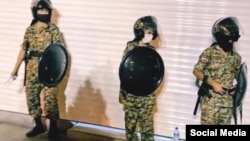Welcome back to The Farda Briefing, an RFE/RL newsletter that tracks the key issues in Iran and explains why they matter.
I'm RFE/RL correspondent Golnaz Esfandiari. Here's what I’ve been following during the past week and what I’m watching for in the days ahead.
The Big Issue
As Iranian authorities crack down on nationwide anti-government protests, photos have appeared on social media that purportedly show children and adolescent boys wearing unforms and holding batons.
They appear to be wearing the uniforms of the Basij paramilitary forces, a branch of Iran's powerful Islamic Revolutionary Guards Corps (IRGC).
The photos have led to accusations that the authorities are using minors to help crush the demonstrations.
Protest rallies erupted soon after the September 16 death of Mahsa Amini, who died days after she was detained by Iran’s morality police. Iran’s Society for the Protection of Children’s Rights expressed concern over the photos, noting that the use of child soldiers was against international law.
Last week, over 500 members and supporters of the Imam Ali Society, a local charity, said the authorities had recruited children from impoverished families to help “suppress” the ongoing street protests. In exchange, the minors received a “few bags of food,” the charity said.
Hadi Ghaemi, the executive director of the New York-based Center for Human Rights In Iran, told me that the “desperate and morally bankrupt government” in Iran “has no regard for its own people” and “its only concern is brutal self-preservation.”
Why It Matters: Iran has a record of using children as combatants, including during the 1980-1988 Iran-Iraq war. More recently, Tehran has been accused of recruiting Afghan refugee children living in Iran to fight in the conflict in Syria. There were also reports that the authorities had recruited minors to suppress protests in 2011.
Journalist Roza Mohtasab from the fact-checking site Factnameh.com said the recent photos, believed to have been taken in Tehran, appear to be genuine. She said the children in the photos appear to be wearing the uniforms of the Student Basij, a subgrouping of the Basij.
"These images have not been manipulated, they're new,” Mohtasab said. “From the evidence that emerged online, we can say that children have been employed in the current round of protests."
Mohtasab said it was not clear what role the minors were playing in the government crackdown. "It could be that this was part of a maneuver for them to become familiar with the situation," she said.
What’s Next: Tehran could employ a greater number of minors to help control the angry protests. There have been mounting reports of security forces becoming exhausted from quelling rallies across the country for nearly four weeks.
“Distributing all your special police forces becomes challenging when the protests are spread out throughout [the country],” analyst Saeid Golkar, who has authored a book on the Basij, told me.
Stories You Might Have Missed
• Sixteen-year-old Nika Shakarami left to join ongoing anti-government protests in Tehran on September 20. She was never seen alive by her family again.
In an exclusive video shared with RFE/RL's Radio Farda, Nika's mother said the family is now being pressured to echo the official account of her daughter's death, and accused the authorities of "lying" in an attempt to "exempt themselves."
• Iran has arrested several digital rights and Internet freedom activists, including Amir Mirmirani who has previously publicly criticized Tehran’s attempts to intensify online censorship.
Mirmirani had accused IT companies SahabPardaz and ArvanCloud of being involved in cutting off Internet access in order to facilitate the suppression of the protests. Dozens of journalists and activists have been arrested since the protests erupted.
What We're Watching
More than 1,000 workers at Iran’s Bushehr and Damavand petrochemical plants joined the protests on October 10. According to RFE/RL's Radio Farda, the oil workers blocked access roads and chanted slogans such as "Death to the dictator!" as they gathered with a heavy security presence nearby.
Some reports suggested that the strikers were contract workers who had also gone on strike last year to demand higher wages and better working conditions. In recent days, there have been reports of sporadic strikes by traders and shop owners in several cities.
Why It Matters: It marks the first time workers in the crucial oil industry have gone on strike. It is unclear if more workers will follow suit.
If more oil workers go on strike, it could have significant ramifications. Major strikes by public employees preceded the Islamic Revolution in 1979, bringing large parts of the economy to a halt.
That’s all from me for now. Don’t forget to send me any questions, comments, or tips that you have.
Until next time,
Golnaz Esfandiari
If you enjoyed this briefing and don't want to miss the next edition, subscribe here. It will be sent to your inbox every Wednesday.







